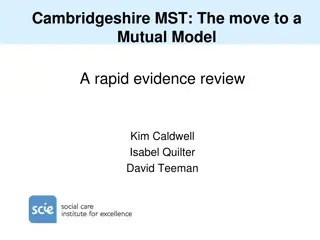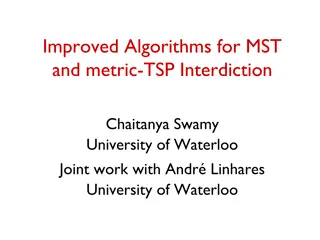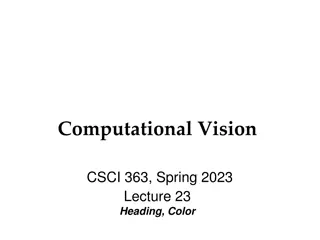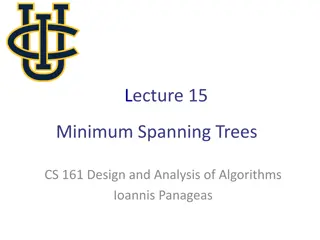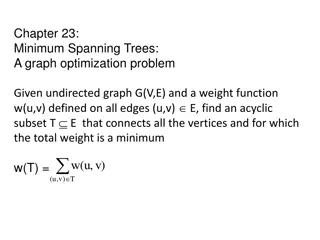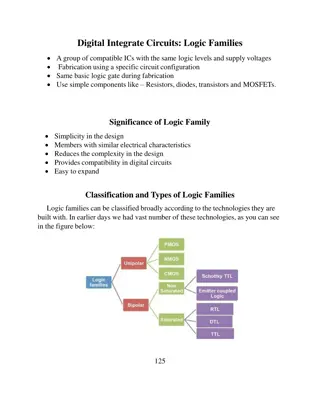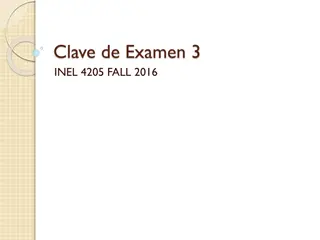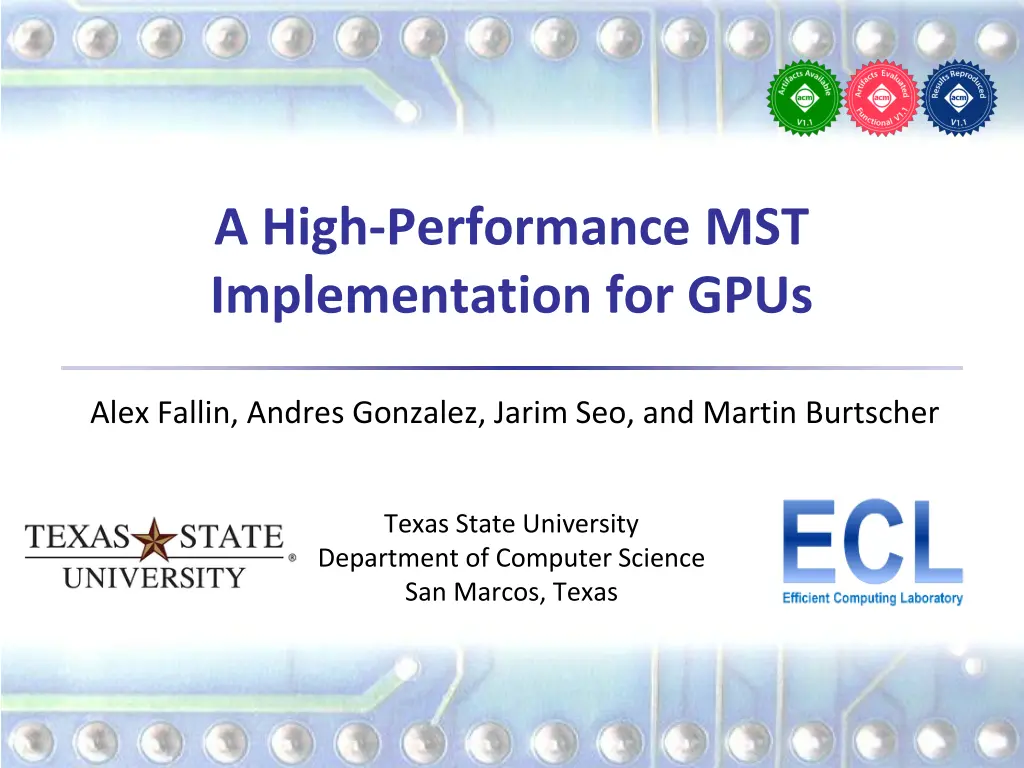
High-Performance MST Implementation GPU
Solving the Minimum Spanning Trees problem efficiently on GPUs - explore MST applications, classic algorithms like Prim's and Kruskal's, and Borvka's algorithm for maximum parallelism. Discover how this technology benefits network analysis, chip design, route planning, medical diagnostics, and more.
Download Presentation

Please find below an Image/Link to download the presentation.
The content on the website is provided AS IS for your information and personal use only. It may not be sold, licensed, or shared on other websites without obtaining consent from the author. If you encounter any issues during the download, it is possible that the publisher has removed the file from their server.
You are allowed to download the files provided on this website for personal or commercial use, subject to the condition that they are used lawfully. All files are the property of their respective owners.
The content on the website is provided AS IS for your information and personal use only. It may not be sold, licensed, or shared on other websites without obtaining consent from the author.
E N D
Presentation Transcript
A High-Performance MST Implementation for GPUs Alex Fallin, Andres Gonzalez, Jarim Seo, and Martin Burtscher Texas State University Department of Computer Science San Marcos, Texas
Minimum Spanning Trees (MSTs) A common graph problem Given a weighted, undirected graph G = (V, E, w) Find a subset of edges E that connects all vertices V such that the total weight is minimized When G is not connected, it becomes a minimum spanning forest (MSF) In this presentation, we use MST for both A High-Performance MST Implementation for GPUs 1
MST Applications Network analysis, chip design, eye tracking, route planning, medical diagnostics, etc. Example: connecting homes with power lines 2 2 C B C B 3 3 2 2 A D A D 1 1 A High-Performance MST Implementation for GPUs 2
Related Work A High-Performance MST Implementation for GPUs 3
Classic MST Prims Algorithm Given a weighted, undirected graph G = (V, E, w) Start from an arbitrary vertex Greedily add the lightest edge that connects to a vertex not already in the growing MST When all vertices are added, the MST is complete Tends to perform better on dense graphs A High-Performance MST Implementation for GPUs 4
Classic MST Kruskals Algorithm Given a weighted, undirected graph G = (V, E, w) Sort E in nondecreasing order Iterate through sorted E from lightest to heaviest If the edge does not create a cycle, add it to the growing MST Once E is processed, the MST is complete Tends to perform better on sparse graphs A High-Performance MST Implementation for GPUs 5
Classic MST Borvkas Algorithm Given a weighted, undirected graph G = (V, E, w) Iteratively merge vertices using their lightest connecting edge Discard all internal edges in the merge that were not the lightest When all vertices are merged, only the lightest connecting edges remain, which form the MST Most parallelism friendly of the classics A High-Performance MST Implementation for GPUs 6
Related Work: Classic Enhancements A High-Performance MST Implementation for GPUs 7
Enhancement: qKruskal An extension of Kruskal s algorithm Instead of sorting the entire edge list, partition it into light and heavy Only the light edge list is sorted initially An MST can often be built using only the light edges Potentially saves expensive sorting work A High-Performance MST Implementation for GPUs 8
Enhancement: Filter-Kruskal Builds on qKruskal When the heaviest edge is in the MST, qKruskal provides no benefit over classic Kruskal s Edges can be checked for cycles faster than they can be sorted Before sorting, filter the cyclic edges out Allows Kruskal s to perform well on dense graphs A High-Performance MST Implementation for GPUs 9
Related Work: Serial and Parallel Implementations A High-Performance MST Implementation for GPUs 10
Jucele 18 Pure MST on the GPU via modified Bor vka s Kernels find and mark lightest edges Merge based on lightest edges, count connected components Repeat until a single connected component exists Vertex-centric, data-driven A High-Performance MST Implementation for GPUs 11
Lonestar CPU-parallel Bor vka s Loops over the edges of all disconnected components and identifies light edges in parallel Merges components using disjoint-set data structure to avoid modifying the graph A High-Performance MST Implementation for GPUs 12
PBBS CPU parallel and serial, based on Kruskal s Uses ideas from both qKruskal and Filter-Kruskal Introduces deterministic reservations, which allows for edges to be added to the MST earlier than basic Kruskal s Speculative for loop is used to execute the iterations of the non-parallel algorithm out of order A High-Performance MST Implementation for GPUs 13
PBBS contd. Using deterministic reservations, commits additions to the MST when they are confirmed to not conflict with an earlier iteration Only sorts k lightest edges to start k = ~|V| If the MST is not complete after the first k edges, filter the rest before sorting A High-Performance MST Implementation for GPUs 14
RAPIDS cuGraph GPU-parallel implementation Based on Bor vka s algorthim Uses vertex-centric, topology-driven color propagation with supervertices Takes advantage of RAFT (Reusable Accelerated Functions and Tools) in its parallelization A High-Performance MST Implementation for GPUs 15
UMinho 15 GPU and CPU-parallel, based on Bor vka s algorithm Vertex-centric, data-driven Finds the minimum edges of each vertex Truly merges vertices that ought to be connected into new supervertices Builds edge list for new, contracted graph A High-Performance MST Implementation for GPUs 16
Gunrock GPU-parallel pure MST Vertex-centric, topology-driven Looks through all vertices Evaluates edges for addition if their source and destination are not in the same connected component A High-Performance MST Implementation for GPUs 17
Our ECL-MST Implementation A High-Performance MST Implementation for GPUs 18
ECL-MST Approach qKruskal: Analyze the input graph, only filter edges when average degree is >4 If we are filtering, process edges that are below a weight threshold This threshold is determined by randomly sampling 20 weights and picking the threshold that corresponds to 4 times the vertex count A High-Performance MST Implementation for GPUs 19
ECL-MST Approach The first worklist (WL) is filled with all weighted edges below threshold Iterate over first WL Acyclic edges are kept and added to a second WL atomicMin is used on edge endpoints, storing the lowest-weight edge in each WL 1 and 2 are swapped A High-Performance MST Implementation for GPUs 20
ECL-MST Approach Candidate edges, now in WL 1, are iterated over If an edge ends up being the minimum of either of its endpoints, add edge to the MST Same concept as deterministic reservations (PBBS) Merge endpoints in disjoint-set data structure Clear minimum edge information Start over processing WL1 A High-Performance MST Implementation for GPUs 21
ECL-MST Approach This edge-based computation loop continues until the first worklist is empty If there are edges left, the worklist is then populated with the remaining edges and the process repeats The resulting tree is an MST for a connected graph and an MSF for a disconnected graph A High-Performance MST Implementation for GPUs 22
ECL-MST Parallelization A High-Performance MST Implementation for GPUs 23
CUDA Parallelization Initialization is trivially parallel Initial population of the worklist is done using a thread if a vertex has fewer than 4 neighbors in its adjacency list, a warp is used otherwise The loops that process the edges in the worklists are parallelized across threads Besides the aforementioned atomicMin, atomicAdd is used for the worklist updates and atomicCAS for the disjoint-set operations A High-Performance MST Implementation for GPUs 24
ECL-MST Performance Optimizations A High-Performance MST Implementation for GPUs 25
ECL-MST Performance Optimizations We stay lock-free by taking advantage of atomics We concatenate the edge weight and the edge ID when marking the smallest edge This conveniently gives us a deterministic tiebreaker and allows for easy retrieval of the edge ID Hybrid parallelization for worklist initialization, lets us use CUDA ballot and shuffle functions to process higher degree vertices more efficiently A High-Performance MST Implementation for GPUs 26
More Performance Optimizations We avoid explicit path compression by storing the results of the find instead of the original vertex IDs in the worklist We use filtering to hopefully only process the light edges that will end up in the MST Edge-centric processing for much of the work helps improve load balance A High-Performance MST Implementation for GPUs 27
Results A High-Performance MST Implementation for GPUs 28
Methodology System 1 GPU: NVIDIA Titan V, 5120 PEs, 80 SMs, 12 GB memory, nvcc 11.7 CPU: AMD Ryzen Threadripper 2950X (16 cores, 3.5GHz), gcc 11.3 System 2 GPU: NVIDIA RTX 3080 Ti, 10240 PEs, 80 SMs, 12 GB memory, nvcc 12.0 CPU: 2x Intel Xeon Gold 6226R (16 cores each, 2.9GHz), gcc 12.2 A High-Performance MST Implementation for GPUs 29
Inputs Eliminated self-loops, multiple edges, made undirected A High-Performance MST Implementation for GPUs 30
System 1 Throughput 32.4 times faster than PBBS Large, scale-free inputs High average degree 4.6 times faster than Jucele , ,5 Mega edges s , 1,5 1, 5 C MST ucele PU unrock PU UMinho PU onestar CPU PBBS CPU Uminho CPU PBBS Serial A High-Performance MST Implementation for GPUs 31
System 2 Throughput 12.8 times as fast as cuGraph 4.5 times as fast as Jucele Generally higher throughput system High average degree Large, scale-free inputs ,5 , ,5 Mega edges s , 1,5 1, 5 C MST ucele PU unrock PU cu raph PU UMinho PU onestar CPU PBBS CPU Uminho CPU PBBS Serial A High-Performance MST Implementation for GPUs 32
Optimization Evaluation , 5, , Mega edges s , , 1, C MST o Atomic uards Thread Based o ilter o Implicit Path Comp Both dge irec ons o Tuples Topology riven ertex Centric ucele A High-Performance MST Implementation for GPUs 33
Summary We present ECL-MST, an optimized and GPU- specialized MST implementation 4.5 faster on average and faster on every input Acknowledgements NSF, NVIDIA, Randy Cornell, Jerry Rosado Code available on GitHub https://github.com/burtscher/ECL-MST Contact: waf13@txstate.edu A High-Performance MST Implementation for GPUs 34





